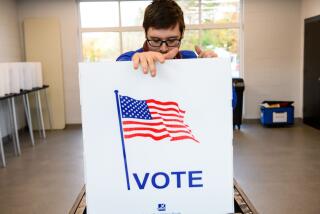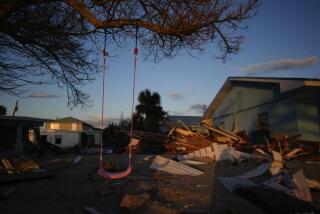An Unconventional Year for New Orleans Visitors
NEW ORLEANS — Police and health officials assured Michael Gorman that New Orleans was safe, and he confirmed in person that its restaurants and night life were back.
Yet more than nine months after Hurricane Katrina inundated 80% of the city, visions of disaster trouble Gorman, dean of library services at Cal State Fresno and president of the American Library Assn.
His group soon will hold the first major convention in New Orleans since its flood walls gave way. With a new hurricane season underway as of June 1, Gorman can’t help but think, “There could be another devastating event.”
“I wake up in the middle of the night and worry about it,” he said. “Of course, the chances are that it won’t happen. It’s early in the season, and we just took an informed chance.”
Convention officials expect 17,000 to 18,000 people at the librarians meeting June 22-28; they probably will stay an average of three nights each. For the city, which relies on visitor taxes and fees for 40% of its general fund, it’s a chance to prove that hotels, restaurants, nightspots, public transit and health services have returned to something like normal.
Travel experts say other professional associations and trade groups will watch closely for cues on scheduling their own meetings, knowing that New Orleans has struggled to overcome not only physical damage but also an acute shortage of workers, a particular challenge for the labor-intensive hospitality industry.
The importance of visitors to New Orleans’ economy can hardly be overstated.
In the eight months of 2005 before Katrina struck, travelers spent $4.2 billion in New Orleans, up from $3.6 billion during the first eight months of 2004, said Jeff Anding, director of convention marketing for the New Orleans Metropolitan Convention and Visitors Bureau.
After the hurricane, 87 conventions and trade shows booked at Ernest N. Morial Convention Center through the end of 2006 were canceled or postponed, according to the convention center. That was a major contributor to an expected decline of $5.5 billion in spending by visitors in the 16 months from Katrina through the end of this year, Anding said.
Conventioneers and business travelers, who charge rooms and meals to expense accounts or write them off as business expenses, are a crucial part of the mix, making up a quarter of all visitors to New Orleans but accounting for 35% or more of visitor spending, Anding said.
The library association had initially projected that 22,000 people would attend its conference. Gorman and others said most members of the group were eager to see New Orleans but others shied away from the scene of disaster.
“Within the library profession there are what I guess you could call a lot of nervous Nellies,” said Lynn Sipe, collection development coordinator for USC’s library system.
Sipe, a veteran New Orleans conventioneer who says he always stays in a small French Quarter hotel, said he had his travel agent check safety issues before booking his latest trip to where “they have some of the greatest food in the world.”
His favorite restaurant, Commander’s Palace, is still closed, but he plans to visit Galatoire’s, the bastion of classic Creole cuisine, and Petunia’s, a neighborhood cafe.
With its rich musical and culinary culture and the nation’s sixth-biggest convention center, New Orleans is a top draw for professional gatherings and trade shows.
Many decision makers, such as Gorman, have decided to go through with conferences they had booked for this year and next year. Others who were forced to cancel meetings generally have been open to rebooking at later dates, according to travel industry officials in the city.
Of the metropolitan area’s 38,343 hotel rooms, about 28,000 have reopened, and many hotels are reporting strong occupancy and revenue, said John A. Williams, co-director of the Hospitality Research Center at the University of New Orleans.
Representatives of the American Translators Assn. visited the city for a week in March, dropping by Galatoire’s and sampling beignets at Cafe du Monde, then touring flood-devastated neighborhoods before confirming that the conference would proceed as scheduled in early November at the Sheraton New Orleans. About 1,600 visitors are expected to stay there and in other hotels.
The group’s president, Marian S. Greenfield, said its members wanted to help a city that, like them, is multilingual and multicultural.
Carolyn Quintero of Long Beach, owner of Inter Lingua Inc., a company with more than 200 translators on call, said it had never occurred to her that the group might move its meeting to another city. Given New Orleans’ history, culture and recent travails, “I think it would be unpatriotic to cancel,” Quintero said.
Such attitudes hearten New Orleans officials, but they remain nervous about the recovery. The threat of even a small hurricane hitting the city could put Mayor C. Ray Nagin’s mass evacuation plans into effect, and fears remain about the strength of flood walls and whether health services could handle major emergencies.
“The truth of the matter is that if we have another hurricane, it will set back our booking pace dramatically,” Anding said. “A lot of associations are doing the right thing and sticking with us. But they also have to make business decisions -- and if another hurricane comes through, they’ll be looking at risking more revenue than they can afford.”
Dr. Karen DeSalvo, chief of general internal medicine at the Tulane University School of Medicine, also expressed worries, saying, “It’s a dicey situation for us in New Orleans.
“We want to ensure economic development, and we want to bring people back to the area,” she said. “But the truth is that the state of the healthcare system is embarrassing, given that it’s the United States of America, nine months after the storm.”
Tulane’s private hospital, part of a hard-hit medical district downtown, recently was operating just 63 of its 200 beds because of budget constraints. Half of the beds were filled with uninsured patients who previously would have gone to Charity Hospital or University Hospital, public facilities closed by the hurricane.
Tulane’s emergency room, where injured tourists traditionally were taken, is now staffed mainly by doctors who used to work next door at Charity. “If you go to the emergency room, you may wait 24 hours to be seen,” DeSalvo said.
Most conventioneers, of course, are unlikely to need an emergency room and may never encounter the devastated side of the city. The tourist areas near the Mississippi River -- the high ground, such as it is, in New Orleans -- are largely intact and open for business, while lower- lying residential neighborhoods such as the middle-class Lakeview and the working-class Lower 9th Ward remain in ruins for mile after mile.
Gorman, the head of the library group, said he had visited New Orleans repeatedly in the past without seeing the Lower 9th and was shocked at the eerie scene when he toured it in April.
“It’s hard to believe unless you go there,” Gorman said. “The conference city, those areas that visitors associate with New Orleans, are in very good shape. But the fact is, they’re surrounded by appalling devastation. I’m dating myself, but I grew up in London during the [Second World] War, and there is just no comparison. It’s as if you went to San Francisco and had Union Square and Fisherman’s Wharf -- and all the rest was gone.”
Away from the worst damage, cabbies and tour guides point out other signs of devastation: floodwater marks on walls like giant bathtub rings, trashed cars abandoned beneath freeways, government trailers on downtown parking lots that house workers for such establishments as Mothers Restaurant, home of “debris” sandwiches made from bits of roast beef that drop into the gravy during slow cooking.
Most high-end restaurants have managed to reopen as well, although -- as the library association informed members on its website -- the labor shortage has restricted some hours and menus.
Away from the tourist areas it’s a different story: Fewer than a third of the 3,718 food outlets that existed in the city before Katrina are back in business, a May 24 count by the Louisiana Restaurant Assn. showed.
Hotel employment is down by 9,000 workers and restaurant employment by 10,000 because so little housing is available, said Williams of the University of New Orleans.
“You’re seeing a lot of multi-skilling going on in restaurants and hotels,” Williams said. “In a hotel, someone might work the front desk, then help with the concierge, and then in slow times be moved to room service.”
Gorman said he had interviewed convention, police and health officials during his visit in April and was assured that services would be “more than adequate.”
Nevertheless, Gorman expects some members of his group to be quick to blame him should problems occur at the librarians meeting.
“My presidency ends at the end of the conference,” he said. “And I could go down as the goat of the century.”
More to Read
Sign up for The Wild
We’ll help you find the best places to hike, bike and run, as well as the perfect silent spots for meditation and yoga.
You may occasionally receive promotional content from the Los Angeles Times.







